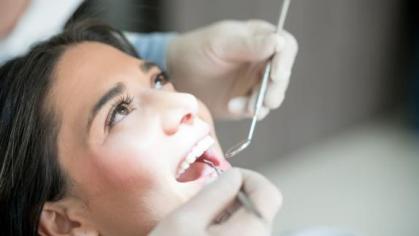Severe Malocclusion? How Oral Surgery Can Help
A lot of people have something called a malocclusion. The term malocclusion refers to any misalignment of the teeth, or when the upper and lower jaws don’t fit together correctly. In most cases, this problem develops in childhood as the result of genetics, birth defects or certain habits such as thumb sucking. While some cases of malocclusion are minor and may not affect a person’s everyday life, other cases can be quite debilitating. Severe malocclusions can alter appearance and make eating, speaking and smiling difficult. Luckily, oral surgery from specialists at Rutgers Health University Dental Associates can help correct these issues and improve patients’ quality of life. Because malocclusion cases also involve orthodontic treatment, our practice is an ideal setting for treatment. All of our specialists are under one roof.
Case Study: Oral Surgery for Smile Improvement
It’s easier to understand how corrective surgery works when you can see a real-life example. So let’s take a look at 19-year-old Devorah Eisemann. She turned to Dr. Shahid Aziz, an oral and maxillofacial surgeon at Rutgers Health University Dental Associates, to help treat her severely misaligned jaw. In her case, she had an underbite, which is when the lower jaw juts forward. Her lower teeth overlapped her top teeth so severely, it was difficult for her to chew. In addition, she began to worry about how the underbite was affecting her appearance.
With help from Dr. Aziz, Eisemann decided to go forward with orthognathic surgery. It was a complicated case but Dr. Aziz had the experience and technology to treat Eisemann successfully, in conjunction with an orthodontist. Dr. Aziz is one of the nation’s most experienced and well-respected orthognathic surgeons. After having her jaw repositioned and wearing braces for a year, Eisemann was excited to show off her new smile to the world.
Different Types of Malocclusion
Eisemann had an underbite, but there are other types of malocclusions, as well. The opposite of an underbite is called an overbite. This is when the upper jaw juts forward and overlaps the bottom one. Another type is known as an open bite, which is when the front teeth don’t come together, even when the jaw is closed. Finally, a crossbite is when the teeth are mismatched and don’t align correctly, usually due to spacing or crowding issues.
Why do some people develop a certain type of malocclusion over another? A lot of different factors come into play. People of all ages, including both kids and adults, seek treatment. It varies for each individual case. In general, however, you can expect to have treatment similar to Eisemann’s. Most dentists will recommend either jaw surgery or corrective appliances, such as retainers or braces, or a combination of both to treat malocclusions.
Do You Have a Malocclusion?
Do you have an underbite, overbite, crossbite, open bite that’s affecting your quality of life? Take the leap and start exploring what your treatment options may be. At this time next year, you could be smiling and chewing better just like Eisemann. Not sure if you have malocclusion? An evaluation with X-rays and teeth impressions can let you know. If not, you may have a different orthodontic condition that we can help you with.
Make an appointment at Rutgers Health University Dental Associates today to find out more. We have offices in both Newark and New Brunswick, NJ and take care of everything under one roof, from simple cleanings to complex surgeries. Call now to get started.



